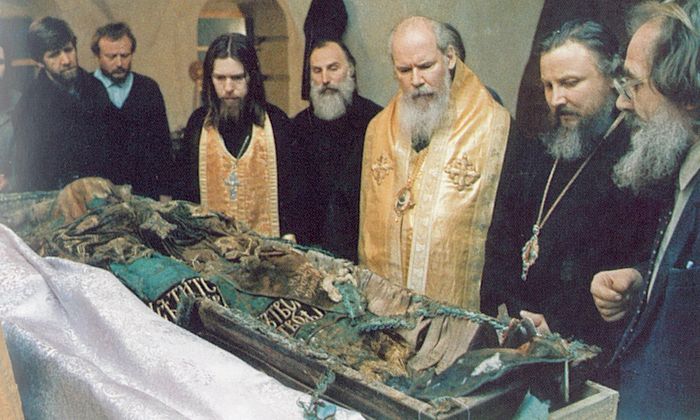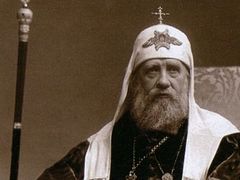In his popular book, Everyday Saints and Other Stories, Bishop Tikhon (Shevkunov) tells the amazing story of how the relics of Patriarch Tikhon were discovered in Donskoy Monastery, Moscow, where he was living as yet a hieromonk at the time. On this day we commemorate that epic event, and present an excerpt from the chapter, “The Relics of Patriarch Tikhon”.
 The uncovering of the relics of Patriarch Tikhon in Donskoy Monastery. Shown are Hieromonk, now Bishop Tikhon, Patriarch Alexiy II, and Bishop Arseny.
The uncovering of the relics of Patriarch Tikhon in Donskoy Monastery. Shown are Hieromonk, now Bishop Tikhon, Patriarch Alexiy II, and Bishop Arseny. One of the many mysteries of ecclesiastical life in Soviet times was what had happened to the remains of the Holy Patriarch Tikhon, who had been buried in 1925 in the Small Cathedral of Moscow’s Donskoy Monastery. In 1946 during his funeral, Metropolitan Nicholas (Yarushevich) of Krutitsa and Kolomna sadly pronounced: “We have just prayed over the grave of His Holiness. But his body is not here.”
There was every reason to be certain of this. It would not have been surprising to anyone if the remains of Patriarch Tikhon had been destroyed. For if Orthodox believers revered the deceased head of the Russian Orthodox Church as a saint, the hatred felt for him by the Bolsheviks was exceptional, even against the background of hysterical anti-religious Soviet persecution. In a “list of enemies of Soviet authority” published back then by the newspaper Izvestiya, Patriarch Tikhon was listed as number one.
The rumor was that in 1927, after the Donskoy Monastery had been closed, Soviet authorities, fearing that his remains might become an object of reverence, removed his coffin from his grave and burned it in a crematorium. There were other reports that the remains of His Holiness had been secretly spirited out and reburied in the German cemetery in Lefortovo. A third version was that the monks, fearing that the authorities would desecrate the remains of the Patriarch, secretly reburied him in a hidden necropolis somewhere in the Donskoy Monastery. All these theories grew into a real conviction that was solidified when in 1932 the leader of the Soviet-supported group of ecclesiastical renovationists, the self-styled Metropolitan Alexander Vvedensky, appeared before his supporters in the vestments of the Patriarch himself. Muscovites immediately recognized these garments as having been sewed specifically for Patriarch Tikhon in the famous factory of the Olovyanishnikov merchant brothers. And Patriarch Tikhon had been buried in these vestments.
And yet hope lingered that the remains of this Patriarch beloved by the entire Church would one day be found.
* * *
It was the evening of the feast of the Meeting of the Lord. We started by saying prayers by the grave of the Patriarch Tikhon, and then began our excavation. Very few people even knew about this: His Holiness Patriarch Alexiy II, several monks, Archimandrite Cyril from the Holy Trinity Monastery, Archimandrite John from the Pskov Caves Monastery, and those whose help we had asked for: Vyacheslav Mikhailovich Klykov and several of his stonemasons and assistants, and also the artist Alexey Valeryevich Artemyev. Our group leader was the learned archaeologist Sergei Alexeyevich Belyayev. He had been responsible for the location of the remains of St. Ambrose of Optina, and had also carried out excavations in the Monastery of Diveyevo and in the Chersonese peninsula, where there used to be Scythians, as well as ancient Greek colonies.
We began by removing the gravestone. After the fire its marble had become practically brown. As we got about thirty centimeters deeper we found a massive marble slab inscribed: “His Holiness Tikhon, Patriarch of Moscow and all Russia.” That was precisely the title of the Russian Orthodox Patriarchs at the beginning of the twentieth century. This find inspired us, as we began to dig deeper, and as we reached one meter more in depth we saw what we had been looking for: the stone vault of a hidden crypt. But as we reached again to remove several stones from the vault of the crypt, I cautiously inserted a burning candle into the cavity that had been formed and glanced inside. The crypt was empty. All the candlelight was able to reveal were the dusty remains of an old spider web.
When I told my friends this, everyone was let down with exhaustion, and for a while we just sat there silently. Then one after another they raced to check whether what I had told them was really true. Had I perhaps made a mistake? Perhaps in the quite roomy crypt there were a few relics or remains of the former remains that had survived the violation of the grave of the Patriarch? But there was absolutely nothing there at all. Our worst fears had been confirmed.
As we calmed down, we decided to document the size and condition of the crypt. But as we were measuring its length, the measuring rod, which was two meters long, unexpectedly quivered to the right and the left. The same thing happened with a rod that was eight meters long. We hurried to investigate this underground structure and soon understood that we had found not a crypt, but a portion of the heating system of the church, containing stone pipes placed under the floor through which the hot air from the stove was conducted. The heater was significantly wider in the area by the Patriarch’s grave, so that it truly did resemble a crypt. Or perhaps the grave was even deeper? Perhaps what we had found was actually a false crypt, specially built this way to deceive the Bolsheviks into believing that the coffin with the body of the Patriarch had already been stolen and buried somewhere else?
Then suddenly Father Daniel brought us a very old man, who asserted that he supposedly knew for sure that the holy prelate Tikhon had been buried exactly five meters to the east of what had been marked as his grave. Our opinions were split after this, and so the next morning we went to visit His Holiness, to ask for his blessing and advice on what to do next. Having listened to all we had to say, the Patriarch blessed our continuing efforts in searches in the same place.
At last by nightfall we finally found the real burial vault of the Patriarch. There could be no doubt about it. It was a very powerful structure covered by an enormous slab, which to our great fortune had not remained whole but was made up of several massive stone sections. We were able to lift up one of them. I lay on my stomach and inserted a candle inside. I remember how I was suddenly struck by a smell of spring freshness emerging from this underground crypt. Everyone gathered round. In front of me was a thin oak coffin of extremely refined carving, whose description I already knew very well. On it there was a marble inscription. By the flickering light of the candle I read: “The Patriarch of Moscow and of all Russia, Tikhon.”
We could not believe how lucky we were. Father Agathadorus immediately left to call Patriarch Alexiy. It was already quite late, near midnight, but the sessions of the Holy Synod had only just finished. Twenty minutes later His Holiness came to Donskoy Monastery. By the time he arrived we had lifted up the other slabs above the vault, and greeted the Patriarch with the sound of bells ringing in celebration. It was midnight, and sounded almost like Pascha.
It is difficult to convey our feelings that night as we stood by the open rediscovered grave of the Patriarch Tikhon. We could not believe that it was all over and that his relics were really there in front of us. I am sure that Patriarch Alexiy felt the same way. But then he said to me: “Nonetheless we had better look—are those truly his relics?”
I donned my priestly stole, because one can only touch remains when one is clad in priestly attire, and lowered myself back down to the crypt. Removing the nails lifting up the carved lid of the coffin, I felt my heart pounding as I put my arm inside. My fingers gingerly touched first fabric, and then a shoulder. “He’s here!” I cried out as loud as I could, “Enough! Come back! Come back! And close the lid quickly!” I heard from above the voice of the Patriarch quivering with emotion.
This took place on February 19. Three days later His Holiness the Patriarch, the members of the Holy Synod, and the father confessors of the Holy Trinity Monastery, Father Kirill (Pavlov) and Father Naum (Baiborodan), came to our monastery. When the weathered lid of the coffin whose carving was collapsing was lifted up, we saw with our own eyes the preserved remains of the Holy Patriarch Tikhon covered by his velvet Patriarchal mantle.
Several days later we washed the holy relics according to an ancient rite, garbed them in new Patriarchal vestments, and placed the relics in a specially prepared shrine. The Patriarch was wearing the very same famous vestments that had been made in the factory of the Olovyanishnikov merchant brothers. After this for a long time we could not understand how it was possible that these same vestments had also been on the false Metropolitan Vvedensky.
In spite of the fact that it had been very humid in the crypt, the body of Patriarch Tikhon, which had been lying in the earth for sixty-seven years, had somehow been almost perfectly preserved. It was remarkable that by contrast one of his panagias, or pectoral icons, a symbol of hierarchical power resting on the breast of Patriarch Tikhon, though it had been made from the ivory of a mammoth tusk, had been completely dissolved into dust over the years. Only the silver frame of the panagea had survived.
We could not help remembering the verse from the Psalm: “Many are the afflictions of the righteous: but the Lord delivereth him out of them all. He keepeth all his bones: not one of them shall be broken.” And yet not just the bones of the Holy Patriarch but most of his body had been preserved as well. Likewise preserved were the great Patriarchal paramon,[1] (his prayer beads, and his monastic paramon, his baptismal cross, and a golden panagia that had been presented to the Patriarch once by the Bishop of Yaroslavl and the parishioners of that diocese. We even found a piece of a palm frond (for the holy prelate Tikhon had been buried on Palm Sunday)—and found as well a little bottle of aromatic rose oil with which the body of the Patriarch had been anointed before his burial.
Sometime later our archeologist Sergei Alexeyevich Belyayev was able to get to the bottom of the mystery of why the “false Metropolitan” Alexander Vvedensky had been seen wearing the Patriarchal vestments. It turned out that in the Olovyanishnikov Factory two sets of vestments had been made. Nowadays the one that truly belonged to the Holy Patriarch Tikhon is on display in the museum of the Donskoy Monastery in Moscow.



